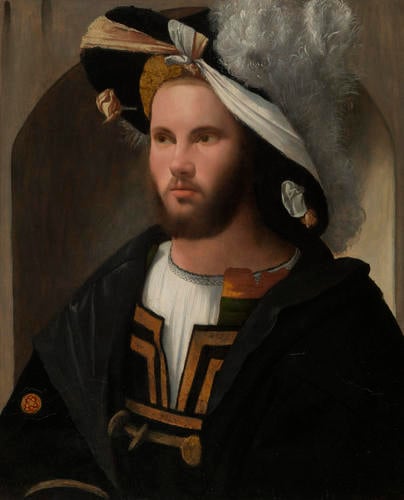-
1 of 253523 objects
Portrait of a Man c. 1515-17
Oil on panel | 58.2 x 47.4 cm (support, canvas/panel/stretcher external) | RCIN 406370

Girolamo Romanino (Brescia c. 1485-1559)
Portrait of a Man c. 1515-17
-
Romanino’s style was influenced by Giorgione and Dürer. In this early work, the sitter wears a wide-brimmed hat over a gold-decorated cap, worn by soldiers in the early sixteenth century to keep their shoulder-length hair out of the way, but the sitter here is probably a north Italian nobleman rather than a professional soldier.
Prince Albert acquired this portrait as a Giorgione and included it in his display of early Italian painting in his Dressing and Writing Room at Osborne House, where it appears in James Roberts's watercolour of 1851 (RCIN 926224). In 1909 Lionel Cust proposed an attribution to the Brescian artist Girolamo Romanino, whose work is very rare in this country. It is now generally accepted as one of Romanino’s earliest portraits, dated c. 1515-17.
The sitter in this portrait wears a wide-brimmed hat over a gold-decorated scuffiotto, a close-fitting coif or cap, usually made of leather or fabric. A similar combination of scuffiotto, large-brimmed hat, ribbons and ostrich feathers is seen in Romanino’s Cremona frescoes. In his Salome of c. 1515-7 (Bodemuseum, Berlin) an ostrich feather sweeps around Salome’s forehead. Ballarin has suggested that the extraordinary hat in the Royal Collection portrait may have been inspired by prints by the German artist Altdorfer.
The green and gold garment on the man’s left shoulder is difficult to decipher. Over it he wears a doublet or possibly a saione, a wide-skirted garment with gold bands. Similar saioni are seen in Raphael’s Mass of Bolsena (Stanze di Elidoro, Vatican) and Romanino’s Crowning of Thorns (Cremona Cathedral). To imitate the gold edging of the saione the artist seems to have painted a yellow glaze on top of silver leaf, which was then decorated with details in red lake. At the man’s waist can be seen the round ornamental double ends of a dagger presumably fixed to a belt.
The sitter was probably a north Italian nobleman rather than a professional soldier, since the latter were usually depicted with more armour and weapons. The badge worn on his right sleeve is rare and yet to be identified; it may indicate that he belonged to a confraternity or order of chivalry similar to the Venetian Compagnie della Calza.
Catalogue entry adapted from The Art of Italy in the Royal Collection: Renaissance and Baroque, London, 2007Provenance
Bought by Prince Albert from Nicholls, May 1846 as a Giorgione (Rough Catalogue no 221); recorded in the Prince Writing Room at Osborne House in 1876 (no 129)
-
Creator(s)
Acquirer(s)
-
Medium and techniques
Oil on panel
Measurements
58.2 x 47.4 cm (support, canvas/panel/stretcher external)
82.1 x 68.9 x 5.0 cm (frame, external)
Category
Object type(s)